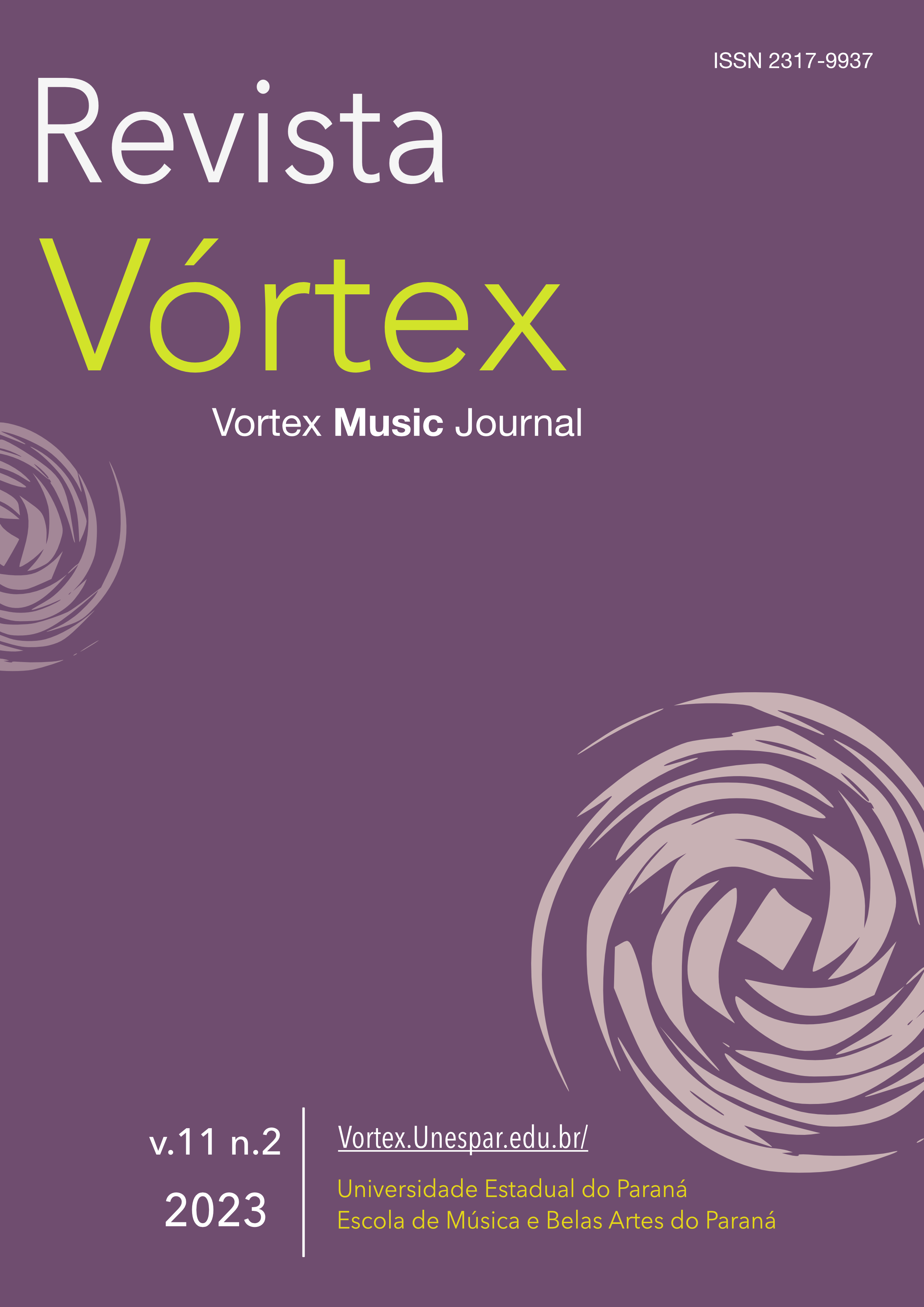Sound board's Frequency Response Analysis of Classical Guitars
DOI:
https://doi.org/10.33871/23179937.2023.11.2.7762Palabras clave:
Classical guitars, Fourier transform, Continuous wavelet transform, Signal processingResumen
The instrument's sound quality assessment is an arduous task to be performed computationally. This work aims to compare high-quality sound characteristics among instruments. The impulse response of the guitar is recording in the time domain and, by means of the Fourier and Continuous Wavelet Transforms the characteristics among high-quality guitars, in the frequency domain, are shown. To discriminate high quality, through experimentation, the criteria are: 1) tuning of notes, sound projection and definition of notes; 2) sound balance at all frequencies and timbre. Comparison of the frequency response (intensity, density, shape, range) gives a good intuition regarding sound quality of the instruments that shares similar characteristics, according to the criteria defined. Note that, among the high-quality classical guitars, it is not possible to define what is better sound-wise due to the fact that high-quality instruments are hearing-perceptual defined, therefore, depends on the criteria of the musician.
Descargas
Citas
BRADLEY, Kevin; CHENG, Mu-Huo; STONICK, Virginia L. Automated analysis and computationally efficient synthesis of acoustic guitar strings and body. Proceedings of 1995 Workshop on Applications of Signal Processing to Audio and Acoustics, 1995, pp. 238-241, Doi: https://doi.org/10.1109/ASPAA.1995.482999
CAHAN, David. Hermann Von Helmholtz Cahan and the Foundations of Nineteenth-Century Science. [S.l.]: University of California Press, 1993. pp. 20.
COBBOLD, Richard S. C., MANBACHI, Amir. Development and application of piezoelectric materials for ultrasound generation and detection. Ultrasound – SAGE Journals, v. 19, n. Issue 4, 2011. pp. 23.
COOLEY, James W.; LEWIS, Peter A. W.; WELSCH, Peter D. Historical notes on the fast Fourier transform. (PDF). IEEE Transactions on Audio and Electroacoustic. 15 (2): 7679. Cite Seer X 10.1.1.467.7209. Doi: https://doi.org/10.1109/tau.1967.1161903
DODGE, Charles.; JERSE, Thomaz.A. Computer music synthesis, composition, and performance. Charmer Books, ed. 2, New York, 1997.
ELBIR, Ahmet; ILHAN, Hamza Osman; SERBES, Gorkem; AYDIN, Nizamettin. Short Time Fourier Transform based music genre classification. Electric Electronics, Computer Science, Biomedical Engineering’s Meeting (EBBT), 2018, pp. 1-4, Doi: https://doi.org/10.1109/EBBT.2018.8391437
FLETCHER, Harvey.; MUNSON, William A. Loudness, its definition, measurement and calculation. Journal of the Acoustical Society of America 5, 82108, 1933.
HAINES, David W. The essential mechanical properties of wood prepared for musical instruments. CAS Journal, Vol. 4, No. 2 (Series II), p. 2032, 2000. pp. 22.
HURD, David C. Left-brain lutherie. Ukuleles by Kawika, Inc., 2004. pp.22.
HUYNH, Du Q. Frequency estimation of musical signals using STFT and multitapers. Proceedings of 6th International Symposium on Image and Signal Processing and Analysis, 2009, pp. 34-39, Doi: https://doi.org/10.1109/ISPA.2009.5297759, 2009.
JANSSON, Erik V. Function, construction and quality of the guitar. Royal Swedish Academy of Music, n. 38, 1983. pp. 29, 31 and 32.
KULKARNI, Urja; KAUSHIK, Shrishti; LOBO, Lanita; SONKUSARE, Reena Comparative Study of Digital Signal Processing Techniques for Tuning an Acoustic Guitar. 7th International Conference on Smart Structures and Systems (ICSSS), 2020, pp. 1-5, Doi: https://doi.org/10.1109/ICSSS49621.2020.9202368
LUCAS, Crisron R.; LEON, Franz de. A Finite-Element Simulation-based Prototyping for Classical Guitars using COMSOL Multiphysics. 9th IEEE International Conference on Control System, Computing and Engineering (ICCSCE), 2019, pp. 115-120, Doi: https://doi.org/10.1109/ICCSCE47578.2019.9068585, 2019.
___________________. Effects of changing material properties on vibration modes of guitar body. 7th IEEE International Conference on Control System, Computing and Engineering (ICCSCE), 2017, pp. 139-143, Doi: https://doi.org/10.1109/ICCSCE.2017.8284394, 2017.
MARKS, Robert J. Introduction to Shannon sampling and interpolation theory. Springer-Verlag, 1991. pp. 20.
MEIER, Eric The Wood Database. 2007. Available Online. Site:<https://www.wood-database.com/>. Date: 11.11.2018. pp. 29.
OPPENHEIMER, Alan V.; SCHAFER, Ronald W. Discrete-Time Signal Processing, Prentice Hall Press, 3rd. ed., USA, 2009.
O’SULLIVAN, Elisabeth A.; WINFREY, William R.; COWAN, Colin F. N. Padé Fourier Methods for Music Transposition. 15th International Conference on Digital Signal Processing, 2007, pp. 543-546, Doi: https://doi.org/10.1109/ICDSP.2007.4288639
ROMANILLOS, José L. Antonio De Torres: Guitar Maker-His Life and Work. [S.l.]: Bold Strummer Ltd, December 1, 1997. pp. 17.
SCHMIDT, Erik M.; MIGNECO, Raymond V.; SCOTT, Jeffrey J.; YOUNGMOO, Kim. Modeling musical instrument tones as dynamic textures. IEEE Workshop on Applications of Signal Processing to Audio and Acoustics (WASPAA), 2011, pp. 329-332, Doi: https://doi.org/10.1109/ASPAA.2011.6082326. 2011.
SONJA, Krstic.; DRAGAN, Drinčić; MIRKO, Milošević. Classical guitar with and without resonator: Comparative analysis of dynamic characteristics. 20th Telecommunications Forum (TELFOR), 2012, pp. 1268-1271, Doi: https://doi.org/10.1109/TELFOR.2012.6419447, 2012.
STANCIU, Mariana D.; VLASE, Sorin; MARIN, Marin. Vibration Analysis of a Guitar considered as a Symmetrical Mechanical System. Symmetry, Vol. 11, N. 6, A.N. 727, ISSN 2073-8994, Doi: https://doi.org/10.3390/sym11060727, 2019.
STEIN, Elias M.; WEISS, Guido. Introduction to Fourier Analysis on Euclidean Spaces (PMS-32). book, Princeton University Press, pp. i-vi. 1971, ISBN 9780691080789.
TEIXEIRA, Paulo Sérgo.; SILVA, Alexandre José da; FEITEIRA, José Flávio. Avaliação e comparação de características de amortecimento de sinais gerados de diferentes violões. Caderno UniFOA, 2014.
Descargas
Publicado
Cómo citar
Número
Sección
Licencia
Derechos de autor 2023 Milton Ernesto Romero Romero, Rafael Pedrosa Salgado, Evandro Mazina Martins

Esta obra está bajo una licencia internacional Creative Commons Atribución 4.0.
Los autores conservan los derechos de autor y conceden a la revista el derecho de primera publicación, con el trabajo simultáneamente bajo la licencia Creative Commons Attribution Licence que permite compartir el trabajo con reconocimiento de autoría y publicación inicial en esta revista.






